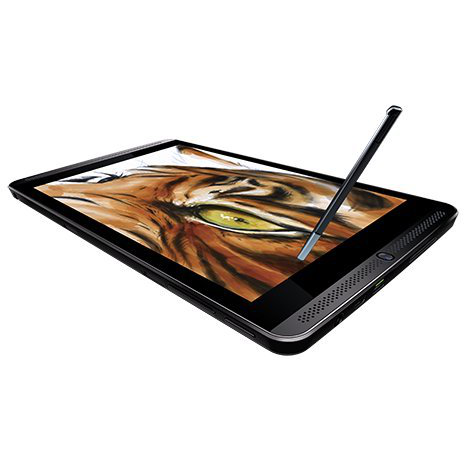Nvidia Explains Why It's Building Shield Family of Devices
There was really no surprise when Nvidia revealed its gaming tablet on Tuesday. We saw plenty of evidence to support its existence over the past several months, and now that it’s here, we have to wonder why Nvidia chose to take the tablet route rather than build upon the first-generation Shield (the Tom's community seemed divided on this issue). The company doesn’t explain why it chose a tablet form factor in its latest blog, but does explain its interest in Android gaming. (Read Tom's Hardware's full coverage of the Shield Tablet here.)
“So far, Android gaming has largely been confined to casual games. But that’s going to change,” writes Nvidia’s Jeff Fisher. “We see a different future for Android gaming. We’re committed to turning Android into a vibrant platform that can excite gamers and provide the foundation for a vibrant industry.”
That’s where the Shield family comes in. Just like the GPUs that transformed the PC industry back in the late 1990s, Nvidia has released two processors that directly affect and enhance Android games, namely the Tegra 4 and the Tegra K1. This time around, Nvidia isn’t just supplying a chip to make visuals pretty and smooth, but has pushed the change even further by developing actual devices that cater to the Android gamer.
Perhaps that’s why Nvidia chose to create a Shield tablet and standalone controller: to offer a gaming solution that also provides mainstream usage (emails, web surfing etc), a factor that just wasn’t ideal on the original Shield handheld. According to Fisher, both products are “purpose built” to give individual gamers what they need in an Android device.
“Like the PC, Android is an open platform,” Fisher wrote. “Like the PC, Android has a huge installed base of users. But the underlying performance, software tools and resulting content have yet to be delivered.” He also said that Nvidia’s goal is to “turbocharge” Android gaming, to inspire developers to create “never-before-seen” experiences.
“Not so long ago, Android gaming was limited to touchscreen controls on your smartphone or tablet,” Fisher wrote. “You could buy a third-party controller. But it was with the hope that everything would somehow work together smoothly. The Shield portable, the first product in our Shield family of Android gaming devices, changed that.”
Nvidia revealed the Shield Tablet on Tuesday. The hardware specifications show that it sports an 8-inch IPS screen with a 1920 x 1200 resolution. Powering this screen is Nvidia’s quad-core Tegra K1 processor clocked at 2.2 GHz and packing 192 Kepler GPU cores. The tablet also features 2 GB of RAM, and a battery that promises up to 10 hours of video playback.
Get Tom's Hardware's best news and in-depth reviews, straight to your inbox.
The specs list also shows a 5MP HDR camera on the front, a 5MP auto focus HDR camera on the back, dual-band Wireless N and Bluetooth 4.0 LE connectivity, and a DirectStylus 2 stylus that can be stored in its own built-in “holster.” Other features include GPS, sensors such as gyro, compass and g-sensor, mini HDMI 1.4 output, a microUSB 2.0 port, front-facing stereo speakers and a 3.5 mm headphone jack with microphone support.
To read Fisher’s full blog, head here.
Follow Kevin Parrish @exfileme. Follow us @tomshardware, on Facebook and on Google+.

Kevin Parrish has over a decade of experience as a writer, editor, and product tester. His work focused on computer hardware, networking equipment, smartphones, tablets, gaming consoles, and other internet-connected devices. His work has appeared in Tom's Hardware, Tom's Guide, Maximum PC, Digital Trends, Android Authority, How-To Geek, Lifewire, and others.
-
mapesdhs The only thing that surprises me about the tablet's specs is the low amountReply
of RAM. Somehow 2GB just doesn't seem like that much these days, but
then I'm not familiar with Android's typical footprint.
Personally I'm more interested in SLI Maxwell to drive a 4K TV...
Ian.
-
-Fran- This one is easy to answer!Reply
Because they haven't been able to sell the chips to 3rd parties thanks to Qualcomm and Samsung :zippy:
Cheers! XD! -
Bondfc11 I am not sure about the tablet. I love the idea, but then pricing everything you need seems to push the price beyond what I would expect to pay. I dunno, but is it me that Nvidia pulled a BMW/Porsche on us by making you buy the cover separately when it seems like an almost must-have for this kind of device? I understand the thought process behind it, but that cover should be part of the base cost (I know not many other tablets do, but this is meant for hands free gaming - with the controller of course.)Reply
Again, I don't know, just don't know (yet). -
itchyisvegeta I really want one that runs Windows so I can play all my Steam games. That or one that doubles as a phone, so I can just carry around 1 device.Reply -
antilycus 2GB in Windows is bad. 2GB in Linux (Android is Java ontop of Linux) is a lot. Memory management and thread processing in Linux is near the best in the industry. I have full production servers running for years and the "swap" file doesn't even exist because the memory is managed well.Reply -
TechyInAZ What the ultimate android gaming tablet will be is one that can run full blown Battlefield x86 on android x86 tablets.Reply
I like that they made a gaming tablet, since light gamers (like me) also do other stuff like web browsing and productivity, and the regular shield (with the built in gamepad) won't deliver good productivity. -
icemunk ReplyI really want one that runs Windows so I can play all my Steam games. That or one that doubles as a phone, so I can just carry around 1 device.
It's not too far off. The Surface Pro is a good step in the right direction.. perhaps a bit big at 12" to be a phone too though, but we'll soon be seeing tablets with 1 teraflop or more of GPU power in the next year or so. The Tegra K1 has 300 gigaflops, which is surprisingly decent, but for PC level graphics we would want at least 1 teraflop. A mid-range GPU on a PC like the 660gtx, or R9 270 produce around 2 teraflops - which can render some pretty nice graphics at full HD resolutions. -
Cazalan NVidia can't seem to make up their mind. You can already buy Android game controllers like that for $15. The ones that attach to the tablet are even better.Reply



